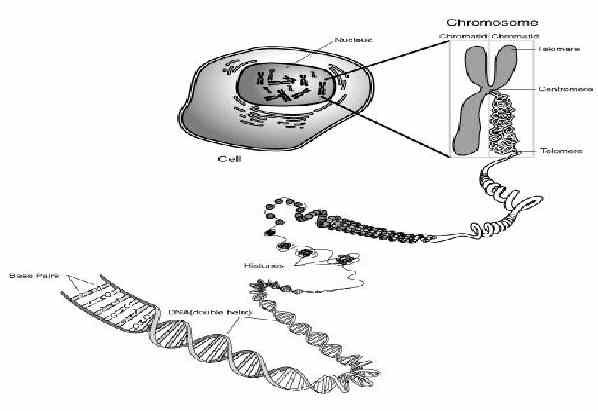Structure of Chromosomes Cell Cycle and Division MCQs ICSE Class 10 Concise Biology Selina Solutions Ch-2. In this article you will get the solutions of MCQs Questions with hint as council latest syllabus. Visit official website CISCE for detail information about ICSE Board Class-10 Biology.

Structure of Chromosomes Cell Cycle and Division MCQs ICSE Class 10 Concise Biology Selina Solutions Ch-2
| Board | ICSE |
| Subject | Biology |
| Class | 10 |
| Book | Selina Concise |
| Chapter-2 | Structure of Chromosomes Cell Cycle and Cell Division |
| Topics | Solutions of MCQs with hint |
| Session | 2024-25 |
MCQs on Structure of Chromosomes Cell Cycle and Cell Division
ICSE Class 10 Concise Biology Selina Solutions Ch-2
Que-1: The chromatin material is formed of
- DNA only
- DNA and Histones
- Histones only
- Nucleotides
Sol: DNA and Histones
Hint: DNA surrounds a core of 8 Histones to form a unit called nucleosome. These nucleosomes coil to form chromatin fibres
Que-2: The term “chromosomes” literally means
- Inherited bodies
- Twisted threads
- Coloured bodies
- Shining threads
Sol: Coloured bodies
Hint: The chromo= dyes and some = body
Que-3: The number of chromosomes in a certain type of cell division is halved. This kind of cell division occurs in
- only testis
- only ovary
- both ovary and testis
- all body cells
Sol: both ovary and testis
Hint: Meiosis takes place in the reproductive organs such as testis and ovary pollen grain ovule.
Que-4: Synthesis phase in the cell cycle is called so for the synthesis of more of
- RNA
- RNA and proteins
- DNA
- Glucose
Sol: DNA
Hint: more DNA is synthesized and the chromosomes are duplicated.
Que-5: In which one of the following options the stages of mitosis have been given in correct sequence?
- Prophase, metaphase, telophase, anaphase
- Prophase, metaphase, anaphase, telophase
- Anaphase, telophase, prophase, metaphase
- Telophase, anaphase, prophase, metaphase
Sol: Prophase, metaphase, anaphase, telophase
Que-6: The new cells are to be produced for all except:
- Growth
- Movement
- Repair
- Replacement
Sol: Movement
Hint: New cells need to be produced for Growth, Repair, Replacement and Reproduction but not for movement
Que-7: The chromosomes are duplicated in :
- M phase
- G1 phase
- S phase
- G2 phase
Sol: S phase
Hint: In Synthesis phase more DNA is synthesized and the duplicated.
Que-8: Triple hydrogen bonds are present between :
- Adenine and Thymine
- Adenine and Cytosine
- Adenine and Guanine
- Guanine and Cytosine
Sol: Guanine and Cytosine
Hint: Triple hydrogen bonds are present between Guanine and Cytosine while Adenine and Thymine has double bond
Que-9: In the cells of a human male body, the number of autosomes is
- 23 pairs
- 22 pairs
- 1 pair
- 46 pairs
Sol: 22 pairs
Hint: in Human total 23 pairs of chromosomes, in which 22 pairs are autosomes while last 23rd pair (1 pair ) is sex chromosome.
Que-10: The basis of genetic variation in the living organisms during mitosis occurs due to
- Cell division
- Mutation
- Crossing over
- Karyokinesis
Sol: Mutation
Hint: Mutations, or changes in the DNA sequence, are the most common cause of genetic diversity in living organisms during mitosis.
Que-11: After a mitotic cell division, a human female cell will have :
- 22 + X chromosomes
- 44 + XY chromosomes
- 44 + XX chromosomes
- 22 + XX chromosomes
Hint: After mitotic cell division, the resulting daughter cells will have the same number and type of chromosomes as the parent cell. A human female cell has 46 chromosomes. Out of these 46, two are sex chromosomes (XX).
Que-12: The correct sequence of phases in interphase is:
- G1, G2 and S
- S, G2 and G1
- G1, S and G2
- G2, S and G1
Sol: G1, S and G2
Hint: The correct sequence is G1 → S → G2.
Que-13: The phase of karyokinesis which is almost the reverse of prophase is :
- Interphase
- Metaphase
- Anaphase
- Telophase
Sol: Telophase
Hint: In telophase, chromatids thin out in the form of chromatin fibres. In prophase, chromosomes become distinct.
Que-14: The lengthwise arrangement of DNA mainly consists of a phosphate group attached with :
- Hexose sugar
- Purines
- Pentose sugar
- Pyrimidines
Sol: Pentose sugar
Hint: The lengthwise arrangement of DNA mainly consists of a phosphate group attached with five-carbon pentose (ribose) sugar.
Que-15: The number of histone proteins associated with the DNA in a nucleosome is:
- 6
- 8
- 4
- 1
Sol: 8
Hint: A nucleosome has 8 histone proteins.
Que-16: The pyrimidine bases of DNA are:
- Adenine and Guanine
- Guanine and Cytosine
- Adenine and Thymine
- Thymine and Cytosine
Sol: Thymine and Cytosine
Hint: Thymine and Cytosine are pyrimidine; and Adenine and Guanine are purine.
Que-17: The female gamete/egg cell of a human cell will have:
- 44 + XX chromosomes
- 44 + XY chromosomes
- 22 + X chromosomes
- 22 + Y chromosomes
Sol: 22 + X chromosomes
Hint: Chromosome number is halved in gametes (sex cells) so the female gamete/egg cell of a human cell will have 22 + X chromosomes.
–: End of Structure of Chromosomes Cell Cycle and Cell Division MCQs ICSE Class 10 :–
Please share with your friends if helpful
Return to : Concise Biology for ICSE Class 10 Selina Solutions
Thanks


